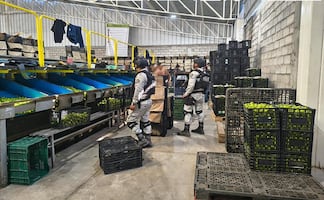Más Información

A 50 días del Plan Michoacán, detienen a 278 personas; realizan recorridos a empacadoras e industrias cítricas

Detienen y vinculan a proceso Alejandro Baruc “N” en Uruapan, Michoacán; podría estar relacionado con el asesinato de Carlos Manzo

Anticorrupción sanciona a tres empresas por proporcionar información falsa; les impide tener contratos con el Gobierno
Mileidy
, Daniel , Adianey , Manuela and Juquila Villalobos López sleep on cushions next to the cot of their grandfather inside a yurt , an emerging house made of PVC pipes that a group of Architecture students of the Isthmus Technological Institute ( Instituto Tecnológico del Itsmo abbreviated ITI ) built them in the family yard.
The Villalobos López family is one of the thousand affected families who lost their home after an 8.2-magnitude earthquake hit Mexico on Thursday, September 7 .
About 7 0,167 homes were damaged and 38,355 are considered uninhabitable due to structural damage .
The Zapotec children remember that the tremor woke them up and that they managed to leave as they could while their grandfather Tomás Toledo López was rescued seconds before the whole house collapsed.
The little yurt is the biggest help the Villalobos López family has received after their house collapsed in a minute.
Solidarity PVC houses

The temporary home was built with a hundred PVC pipes thanks to the support of the Seven Jaguar Collective ( Colectivo Siete Jaguares ), of the city of Oaxaca , who trained three members of Collective 8.2 ( Colectivo 8.2 ) who are Architecture undergraduates at the ITI: Luis Angel Sánchez Tadeo , Jesús Santiago and Ana Cristina Sarabia de León .
The students have decided to continue building temporary houses for the victims of the earthquake, both in Juchitán and in other towns.
Families from Ixtaltepec , Juchitán and Tehuantepec had been trained to build the housing model. Between eight and ten people can live in the yurt and it has an approximate production cost of MXN$ 6,500.
Alaín Lartigue
, a Seven Jaguar Collective member explains that after the earthquake hit the country, they decided to build sustainable housing and the yurt concept came to their mind.
The yurt was developed thousands of years ago by the Mongols , people from Central Asia .
Luis Angel Sánchez
details that the structure of the yurt has four meters wide and four meters high, and it can open up to six meters in diameter.
For the production of a yurt, PVC pipes of 2.50 and 2.30 centimeters are used, 81 meters of waxed rope, five of reinforced cloth, 100 meters of plastic galvanized metal cable, white thermal cloth or denim fabric, among other elements.
Luis Ángel Sánchez Tadeo
emphasizes that it is a pilot project sustained entirely by citizen contributions. So far, they have trained people from Tehuantepec and Ixtaltepec who will be in charge of reproducing the model and as donations continue, the number of yurts will increase.
"You give a family a home and you train others who want to replicate it as well," members of the Seven Jaguar Collective say and they affirm that their main goal is to create a network in the different towns of Oaxaca to reproduce the model.
sg
Noticias según tus intereses
[Publicidad]
[Publicidad]











